Magnetic Particle Testing
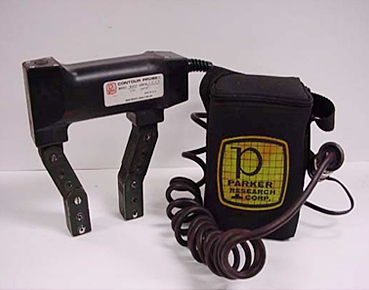
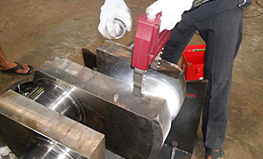
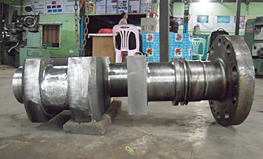
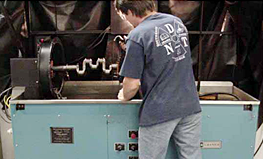
Gloassary of Terms
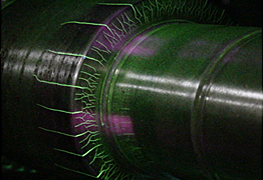 Black Light: ultraviolet light which is filtered to produce a wavelength of approximately 365 nanometers. Black light will cause certain materials to fluoresce.
Black Light: ultraviolet light which is filtered to produce a wavelength of approximately 365 nanometers. Black light will cause certain materials to fluoresce.- Central conductor: an electrically conductive bar usually made of copper used to introduce a circular magnetic field in to a test specimen.
- Coil: an electrical conductor such a copper wire or cable that is wrapped in several or many loops that are brought close to one another to form a strong longitudinal magnetic field.
- Discontinuity: an interruption in the structure of the material such as a crack.
- Ferromagnetic: a material such as iron, nickel and cobalt or one of it’s alloys that is strongly attracted to a magnetic field.
- Heads: electrical contact pads on a wet horizontal magnetic particle inspection machine. The part to be inspected is clamped and held in place between the heads and shot of current is sent through the part from the heads to create a circular magnetic field in the part.
- Leakage field: a disruption in the magnetic field. This disruption must extend to the surface of the part for particles to be attracted.
- Non-relevant indications: indications produced due to some intended design feature of a specimen such a keyways, splines or press fits.
- Prods: two electrodes usually made of copper or aluminum that are used to introduce current in to a test part. This current in turn creates a circular magnetic field where each prod touches the part. (Similar in principal to a welding electrode and ground clamp).
- Relevant indications: indications produced from something other than a design feature of a test specimen. Cracks, stringers, or laps are examples of relevant indications.
- Suspension: a bath created by mixing particles with either oil or water.
- Yoke: a horseshoe magnet used to create a longitudinal magnetic field. Yokes may be made from permanent magnets or electromagnets.
Introduction
- Intended to present information on the widely used method of magnetic particle inspection.
- Magnetic particle inspection can detect both production discontinuities (seams, laps, grinding cracks and quenching cracks) and in-service damage (fatigue and overload cracks).
Outline
- Magnetism and Ferromagnetic Materials
- Introduction of Magnetic Particle Inspection
- Basic Procedure and Important Considerations
- Component pre-cleaning
- Introduction of magnetic field
- Application of magnetic media
- Examples of MPI Indications
Introduction to Magnetism
Magnetism is the ability of matter to attract other matter to itself. Objects that possess the property of magnetism are said to be magnetic or magnetized and magnetic lines of force can be found in and around the objects. A magnetic pole is a point where the a magnetic line of force exits or enters a material.
Magnetic fields are:
- Form complete loops.
- Do not cross.
- Follow the path of least resistance.
- All have the same strength.
- Have a direction such that they cause poles to attract or repel.
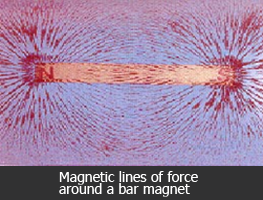
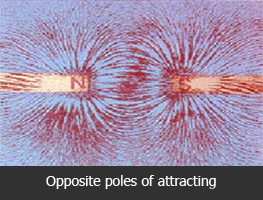
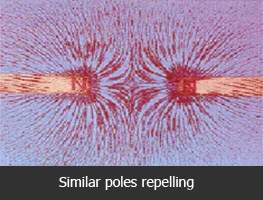
Ferromagnetic Materials
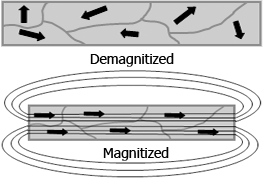 A material is considered ferromagnetic if it can be magnetized. Materials with a significant Iron, nickel or cobalt content are generally ferromagnetic.
A material is considered ferromagnetic if it can be magnetized. Materials with a significant Iron, nickel or cobalt content are generally ferromagnetic.- Ferromagnetic materials are made up of many regions in which the magnetic fields of atoms are aligned. These regions are call magnetic domains.
- Magnetic domains point randomly in demagnetized material, but can be aligned using electrical current or an external magnetic field to magnetize the material.
How Does Magnetic Particle Inspection Work?
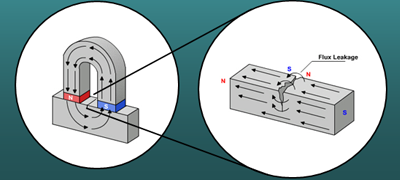 A ferromagnetic test specimen is magnetized with a strong magnetic field created by a magnet or special equipment. If the specimen has a discontinuity, the discontinuity will interrupt the magnetic field flowing through the specimen and a leakage field will occur.
A ferromagnetic test specimen is magnetized with a strong magnetic field created by a magnet or special equipment. If the specimen has a discontinuity, the discontinuity will interrupt the magnetic field flowing through the specimen and a leakage field will occur.
Finely milled iron particles coated with a dye pigment are applied to the test specimen. These particles are attracted to leakage fields and will cluster to form an indication directly over the discontinuity. This indication can be visually detected under proper lighting conditions.
